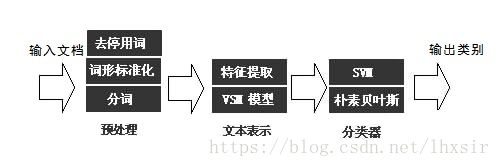中文短文本分类
特征提取+朴素贝叶斯模型:
import random
import jieba
import pandas as pd
#加载停用词
stopwords=pd.read_csv('D://input_py//day06//stopwords.txt',index_col=False,quoting=3,sep="\t",names=['stopword'], encoding='utf-8')
stopwords=stopwords['stopword'].values
#加载语料
laogong_df = pd.read_csv('D://input_py//day06//beilaogongda.csv', encoding='utf-8', sep=',')
laopo_df = pd.read_csv('D://input_py//day06//beilaopoda.csv', encoding='utf-8', sep=',')
erzi_df = pd.read_csv('D://input_py//day06//beierzida.csv', encoding='utf-8', sep=',')
nver_df = pd.read_csv('D://input_py//day06//beinverda.csv', encoding='utf-8', sep=',')
#删除语料的NAN行
laogong_df.dropna(inplace=True)
laopo_df.dropna(inplace=True)
erzi_df.dropna(inplace=True)
nver_df.dropna(inplace=True)
#转换
laogong = laogong_df.segment.values.tolist()
laopo = laopo_df.segment.values.tolist()
erzi = erzi_df.segment.values.tolist()
nver = nver_df.segment.values.tolist()
#定义分词和打标签函数preprocess_text
#参数content_lines即为上面转换的list
#参数sentences是定义的空list,用来储存打标签之后的数据
#参数category 是类型标签
def preprocess_text(content_lines, sentences, category):
for line in content_lines:
try:
segs=jieba.lcut(line)
segs = [v for v in segs if not str(v).isdigit()]#去数字
segs = list(filter(lambda x:x.strip(), segs)) #去左右空格
segs = list(filter(lambda x:len(x)>1, segs)) #长度为1的字符
segs = list(filter(lambda x:x not in stopwords, segs)) #去掉停用词
sentences.append((" ".join(segs), category))# 打标签
except Exception:
print(line)
continue
sentences = []
preprocess_text(laogong, sentences, 0)
preprocess_text(laopo, sentences, 1)
preprocess_text(erzi, sentences, 2)
preprocess_text(nver, sentences, 3)
random.shuffle(sentences)
# 输出前10条数据
# for sentence in sentences[:10]:
# print(sentence[0], sentence[1]) # 下标0是词列表,1是标签
# 定义文本抽取词袋模型特征
from sklearn.feature_extraction.text import CountVectorizer
vec = CountVectorizer(
analyzer='word', # tokenise by character ngrams
max_features=4000, # keep the most common 1000 ngrams
)
# 把语料数据切分
from sklearn.model_selection import train_test_split
x, y = zip(*sentences)
x_train, x_test, y_train, y_test = train_test_split(x, y, random_state=1256)
# 把训练数据转换为词袋模型
vec.fit(x_train)
# 算法建模和模型训练
from sklearn.naive_bayes import MultinomialNB
classifier = MultinomialNB()
classifier.fit(vec.transform(x_train), y_train)
# 计算 AUC 值
print(classifier.score(vec.transform(x_test), y_test))
结果评分为:0.6587
特征提取+svm模型:
import random
import jieba
import pandas as pd
#加载停用词
stopwords=pd.read_csv('D://input_py//day06//stopwords.txt',index_col=False,quoting=3,sep="\t",names=['stopword'], encoding='utf-8')
stopwords=stopwords['stopword'].values
#加载语料
laogong_df = pd.read_csv('D://input_py//day06//beilaogongda.csv', encoding='utf-8', sep=',')
laopo_df = pd.read_csv('D://input_py//day06//beilaopoda.csv', encoding='utf-8', sep=',')
erzi_df = pd.read_csv('D://input_py//day06//beierzida.csv', encoding='utf-8', sep=',')
nver_df = pd.read_csv('D://input_py//day06//beinverda.csv', encoding='utf-8', sep=',')
#删除语料的NAN行
laogong_df.dropna(inplace=True)
laopo_df.dropna(inplace=True)
erzi_df.dropna(inplace=True)
nver_df.dropna(inplace=True)
#转换
laogong = laogong_df.segment.values.tolist()
laopo = laopo_df.segment.values.tolist()
erzi = erzi_df.segment.values.tolist()
nver = nver_df.segment.values.tolist()
#定义分词和打标签函数preprocess_text
#参数content_lines即为上面转换的list
#参数sentences是定义的空list,用来储存打标签之后的数据
#参数category 是类型标签
def preprocess_text(content_lines, sentences, category):
for line in content_lines:
try:
segs=jieba.lcut(line)
segs = [v for v in segs if not str(v).isdigit()]#去数字
segs = list(filter(lambda x:x.strip(), segs)) #去左右空格
segs = list(filter(lambda x:len(x)>1, segs)) #长度为1的字符
segs = list(filter(lambda x:x not in stopwords, segs)) #去掉停用词
sentences.append((" ".join(segs), category))# 打标签
except Exception:
print(line)
continue
sentences = []
preprocess_text(laogong, sentences, 0)
preprocess_text(laopo, sentences, 1)
preprocess_text(erzi, sentences, 2)
preprocess_text(nver, sentences, 3)
random.shuffle(sentences)
# 把语料数据切分
from sklearn.model_selection import train_test_split
x, y = zip(*sentences)
x_train, x_test, y_train, y_test = train_test_split(x, y, random_state=1256)
# 改变特征向量模型
from sklearn.feature_extraction.text import CountVectorizer
vec = CountVectorizer(
analyzer='word', # tokenise by character ngrams
ngram_range=(1,4), # use ngrams of size 1 and 2
max_features=20000, # keep the most common 1000 ngrams
)
vec.fit(x_train)
# 用svm算法进行模型训练
from sklearn.svm import SVC
svm = SVC(kernel='linear')
svm.fit(vec.transform(x_train), y_train)
print(svm.score(vec.transform(x_test), y_test))
结果评分为:0.9976
